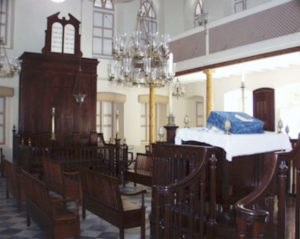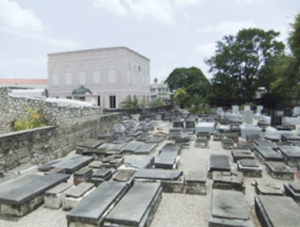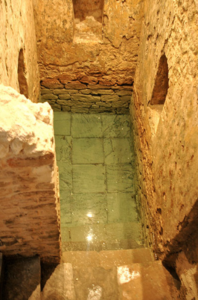 The first synagogue in Barbados was built about 1651 by Jews from Recife, Brazil, fleeing Portuguese lands to English territories during the Inquisition. The original building was destroyed in a hurricane in 1831, and rebuilt two years later.
The first synagogue in Barbados was built about 1651 by Jews from Recife, Brazil, fleeing Portuguese lands to English territories during the Inquisition. The original building was destroyed in a hurricane in 1831, and rebuilt two years later.
The Bridgetown synagogue, deconsecrated early in the century, was seized by the Barbados Government about five years ago and scheduled for demolition. But through the tenacity of the island’s tiny Jewish community, it is now a Barbados National Trust property and is undergoing a $1 million restoration.
The building, a short walk from the main shopping district, is to be rededicated as a synagogue when the restoration is finished and will remain a National Trust property. Today, the building’s exterior, with its balustraded roofline, lancet-shaped windows and thick walls with rounded corners, appears much as it did in the 1830’s, the prosperous days of Barbados’s Jewish community, which led the island’s sugar industry. The synagogue, widely considered one of the oldest such buildings in the Western Hemisphere, features a dark wood ark, grand European chandeliers, a stained-glass window etched with the Star of David, and black and white marble floors.
 The cemetery, with 400 graves, has been cleaned and the stones repaired. Some are inscribed in Hebrew, English and Ladino, a blend of Spanish and Hebrew spoken in the Sephardic community.
The cemetery, with 400 graves, has been cleaned and the stones repaired. Some are inscribed in Hebrew, English and Ladino, a blend of Spanish and Hebrew spoken in the Sephardic community.
These stones tell many stories. One says, ”Underneath this tomb lies the earthly remains of Benjamin Massia . . . . He had been reader of the Jews Synagogue for many years without fee or reward and performed the office of Circumciser with great applause and dexterity.’
Besides repairing broken stones, the text has been chiseled onto the stones lost letters, using for guidance inscriptions from Shilstone’s book – as well as some records found at the Bevis Marks Synagogue.
 Located in the grounds is a full immersion Mikveh, a ritual bath for purifying the body, which dates back to the 17th century. It was discovered in 2009, under a parking lot.
Located in the grounds is a full immersion Mikveh, a ritual bath for purifying the body, which dates back to the 17th century. It was discovered in 2009, under a parking lot.
An entire staircase of granite and marble emerged leading down to the 17th-century bath. Measuring roughly 8 feet by 4 feet, the space is floored with red granite tiles and flanked by alcoves where lamps would have been placed.
The spring that fed the bath is still active, and the water still pure. It has been restored and is confirmed as the oldest Mikve of total immersion which is fed by a natural spring in the Western Hemisphere, and even, which has been created prior to the construction of the original synagogue.